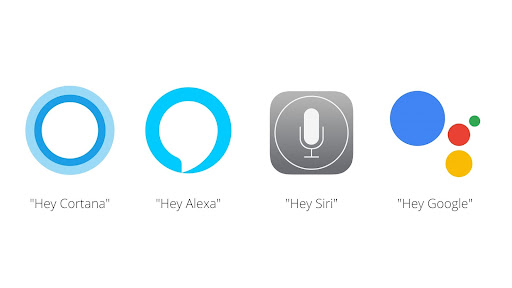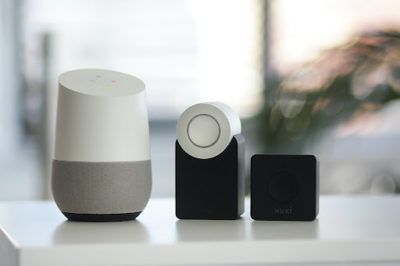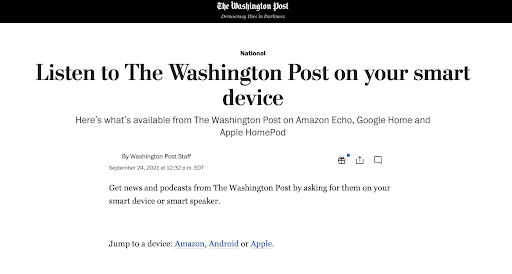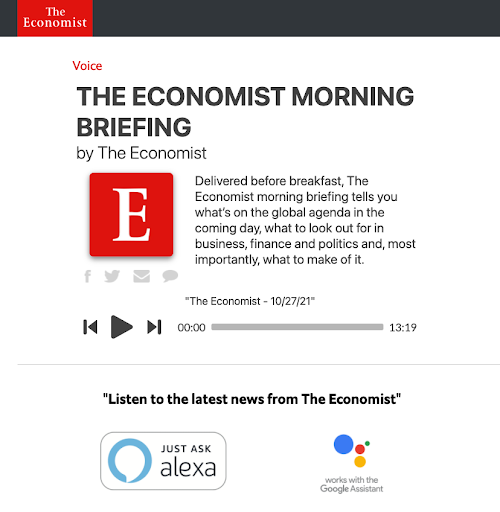AI voice assistants, also known as virtual digital assistants, are based on artificial intelligence technology that helps computers to learn from past experience. What is characteristic of these devices, they use AI to recognize and respond to voice commands. Most of us have these kinds of solutions in our smartphones.
Since 2011, the most important technology companies in the world have created solutions based on voice solutions giving them specific names, e.g.:
- Apple – Siri (2011),
- Amazon – Alexa (2014),
- Microsoft – Cortana (2014),
- Google – Google Assistant (2016),
- Samsung – Bixby (2017).

I won’t dig into the technical aspect of how these such devices work, but I’d like to point out that they use many Artificial Intelligence domains like speech recognition, machine learning, deep learning, or natural language processing.
The rapid development of these areas is the basis for estimates that nearly 92.3 percent of smartphone users will be using voice assistants by 2023 (according to eMarketer forecasts). Already last year 1 in 4 U.S. adults owned a smart speaker (i.e., Google Home, Amazon Echo) what means that 157 million of these devices are in American homes.
Voice assistants aren’t distant future and luxury goods. We are talking about solutions that are becoming more and more common and are available here and now.
What are AI voice assistants used for?
AI voice assistants have a real economic utility both for individual users and different kinds of enterprises in many industries like law, healthcare, security, finance, enterprise, health, or games.
Let’s give you an example.
Imagine you work in a laboratory where you have to wear thick gloves and special suits for safety reasons (it hasn’t been so uncommon during Covid-19). It isn’t comfortable, is it? Especially when you have to type anything or push buttons. How differently it would look like when switches will be operated by voice.
It may be the same with our homes – you come back after work and only with your voice and appropriate commands you can turn on the light and coffee maker or fill the bathtub with hot water and much more.
AI devices can make calls, send text messages, look things up online, provide directions, open apps, set appointments on our calendars, organize meetings, check inventories, verify information, control devices… The list seems to be endless.
In one word, AI voice assistants could change every aspect of our lives by automating tasks. This also applies to the publishing sphere, both on the part of the publisher and the reader.
AI voice assistants in publishing
The world of new technologies gives great opportunities to different kinds of publishers to grow their businesses. First of all, they can publish and monetize their content thanks to digital kiosks or mobile apps. Of course, it requires a lot of effort, and above all, opening up to novelties and adapting to keep up with changes. However, the profits can be absolutely rewarding.
Thanks to AI voice assistants, publishers and authors have a chance to upgrade their promotion, distribution, recognition, and discoverability, while the convenience that the recipients will gain may be invaluable. These devices allow them to connect to users in a new context, and new formats.
Wouldn’t it be more convenient to say a voice command to listen to the daily morning news instead of scrolling, swiping, and typing, especially when you are in a rush? Or when you want to read something and look for recommendations, it may turn out that artificial intelligence knows you and your preferences better than you thought.
It makes sense for every field of publishing, but we can observe the biggest interest in AI voice assistants by news publishers – they experiment with this technology the most often now.
How do publishers use voice assistants?
You’ll find three news publishers below, who started experimenting with voice technology some time ago. They’re still investing in it. What connects all of them? They are news publishers giants, they have an established position in the market, and hence popularity and money, and they are ready to experiment.
The Washington Post
Despite the fact that they are one of the most recognizable newspaper brands in the world, they still feel the necessity to develop and distinguish themselves among others. Their attempts to create voice solutions are caused by the need to prepare something different from news bulletins offered by other publishers.
The Washington Post’s fans can listen to the news and podcasts on their smart devices: Amazon Echo, Google Home, and AppleHomePod. They describe briefly on their website how to get this content.
They also see monetization potential in audio formats. It can be short (less than 10 seconds) pre-roll advertising. The second goal is supporting subscriptions, with a priority on expanding the overall audience.
The New York Times
“If you have a smart speaker or another device with a voice assistant, you can start your day with a short audio briefing, listen to Times podcasts like The Daily, get tips for healthy living or do our guided workout, all by using your voice.” – we read on The New York Times website.
Like The Washington Post, The New York Times informs what’s their offer includes and instructs clearly on how to use digital assistants.
Content from our partners
What do they offer?
- flash briefing including daily tips for living a healthier life,
- weekdays three-minute rundown of the day’s top stories,
- daily news podcast, available five days a week,
- 6-minute workout.
According to Dan Sanchez, editor of voice platforms, one of the biggest challenges is the discoverability of voice content, as many smart speakers do not have visual displays.
The Economist
The Economist has been a pioneer in audio for many years. The goal of their voice strategy is to bring in a new generation of subscribers, not monetize.
People can listen to the latest news from The Economist thanks to Alexa and Google Assistant. The morning briefing is delivered before breakfast and tells listeners what’s on the global agenda in the coming day, what to look out for in business, finance, politics and, most importantly, what to make of it.
Challenges faced by publishers
Despite the huge potential of voice technology in the news industry, and a huge opportunity for innovation and growth, mostly big brands try to use it. They treat it more like a marketing source of new readers than a dominant source of revenue.
This is because publishers see several challenges related to AI assistants. Let’s take a look at some of them.
- The rapid development of technology. Publishers who want to invest in voice-driven solutions need to move fast to adapt to the new technology era. Any investment in new technologies brings with it the need to be up to date with every novelty and trend in its scope.
- SEO. The prevalence of voice technology will also affect SEO. The user who says out loud his query will use different words for this than the one who enters the text into the search engine thanks to the keyboard. It means changes for many SEO agencies as well.
- Monetization. Many publishers ask questions about how to monetize voice technology. Profits from such an activity can be considered in two categories. Firstly, money–voice programs can include short (few seconds) advertising before or after the material. Secondly, an audience – audio products may also support subscriptions of digital or print versions. Voice technology can also be a free value add for subscribers.
- New employees. All activities related to voice technology implementation require initial costs and the employment of new specialized staff or companies. The growing popularity of voice-over solutions will surely result in the emergence of companies offering publishers special services in this field.
The future is voice-controlled
AI voice assistants have slowly entered the publishing market, and news publishers have started to see potential in audio formats. I believe that along with the progress of voice technology and AI, more publishers will see the value of implementing it.
According to Nic Newman’s report, these solutions have a few important benefits for users:
- the speed with which they can access information,
- it is fun to use voice assistants,
- it helps some older groups access the news.
Publishers should already be aware of this technology, its possibilities, and be prepared for making their content suitable for voice search and for other natural language processing applications. Every entrepreneur should remember that in fact, the voice is the future of brand interaction and customer experience.
However, the challenges and costs posed by voice technology make that only the largest brands take their first (or second) steps in this field. The well-known newspaper publishers have already had some experiments with Alexa and Google Assistant behind them. They treat it as an investment in the future. After all, the future belongs to the generations for which voice control will not be anything strange, but natural.



 The Washington Post
The Washington Post The New York Times
The New York Times


 The Economist
The Economist





